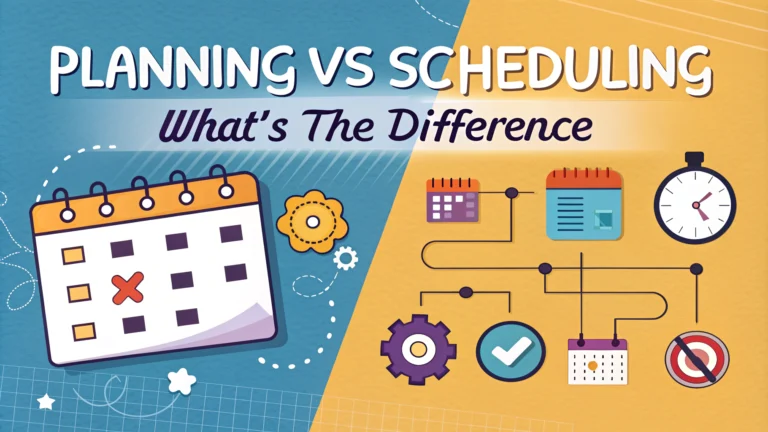Planning and scheduling represent two distinct but interconnected management practices. While often used interchangeably, these two processes serve different purposes in project and time management.
A clear understanding of the differences between
Key Differences Between Planning and Scheduling
- Planning = Strategic process focusing on objectives and resources
- Scheduling = Tactical process dealing with timelines and execution
- Planning comes before scheduling in the project lifecycle
- Planning is flexible, scheduling is more rigid
Essential Elements of Effective Planning
Goal Setting : Defining clear objectivesResource Assessment : Identifying available resourcesStrategy Development : Creating action frameworksRisk Analysis : Identifying potential obstacles
Components of Successful Scheduling
Timeline Creation : Setting specific dates and deadlinesResource Allocation : Assigning specific resources to tasksTask Dependencies : Mapping relationships between activitiesBuffer Management : Including time for unexpected delays
| Planning Characteristics | Scheduling Characteristics |
|---|---|
| Long-term focus | Short-term focus |
| Strategic approach | Tactical approach |
| Defines what needs to be done | Determines when tasks will be done |
“Planning without scheduling is just a wish; scheduling without planning is chaos.”
Tools and Technologies for Planning and Scheduling
Modern planning and scheduling tools help teams streamline their workflows and improve collaboration. Selecting the right tools depends on project complexity and team requirements.
Popular Planning Tools
Project Management Software : Asana, Trello, BasecampMind Mapping Tools : MindMeister, XMindStrategy Planning Software : Monday.com, Smartsheet
Scheduling Solutions
Calendar Tools : Google Calendar, Microsoft OutlookResource Management : Resource Guru, FloatGantt Chart Software : Microsoft Project, TeamGantt
Common Challenges and Solutions
| Challenge | Solution |
|---|---|
| Resource conflicts | Implement resource leveling techniques |
| Scope creep | Regular plan reviews and change control |
| Poor communication | Use collaborative tools and regular check-ins |
Best Practices for Integration
Successful integration of planning and scheduling requires clear communication channels and standardized processes.
Regular Updates : Schedule weekly plan reviewsDocumentation : Maintain centralized project documentationTeam Involvement : Include key stakeholders in planningFeedback Loops : Create mechanisms for continuous improvement
“The best plans are worthless without proper execution through scheduling.”
Moving Forward with Better Management Practices
Effective planning and scheduling create a foundation for project success. Regular evaluation and adjustment of both processes ensure continuous improvement.
Action Steps
- Audit current planning and scheduling processes
- Identify gaps and improvement areas
- Select appropriate tools for your team
- Train team members on best practices
- Monitor and measure results
Remember to maintain flexibility while staying committed to core objectives. Track progress and adjust strategies based on real-world results.
Planning vs Scheduling FAQs
What is the main difference between planning and scheduling?
Planning determines what needs to be done and outlines strategies, while scheduling decides when specific tasks will be executed and allocates resources.
How long does a typical project planning phase take vs scheduling?
Project planning typically takes 10-25% of the total project timeline, while scheduling is an ongoing process that continues throughout the project lifecycle.
Which comes first in project management – planning or scheduling?
Planning always precedes scheduling. You need to know:
- Project objectives
- Required resources
- Major deliverables
before creating a schedule.
What tools are used for project planning vs project scheduling?
Planning tools:
- Mind mapping software
- Strategy documents
- Work breakdown structures
Scheduling tools:
- Gantt charts
- Calendar software
- Project management platforms
Can project scheduling be done without planning?
No, effective scheduling requires prior planning. Without proper planning, schedules lack strategic direction and resource allocation basis.
What are the key components of a project plan vs a project schedule?
Plan components:
- Project scope
- Objectives
- Resource requirements
- Risk assessments
Schedule components:
- Task durations
- Dependencies
- Start/end dates
- Resource assignments
How often should project plans and schedules be updated?
Plans typically require quarterly reviews or when major changes occur. Schedules need weekly or bi-weekly updates to track progress accurately.
What role does resource allocation play in planning vs scheduling?
In planning, resource allocation identifies required resources. In scheduling, it determines specific timing and availability of those resources.
How do agile methodologies approach planning vs scheduling?
Agile planning focuses on product backlogs and sprint planning, while agile scheduling deals with sprint timeboxes and daily task organization.
What are common mistakes in project planning vs scheduling?
Planning mistakes:
- Inadequate risk assessment
- Unclear objectives
- Incomplete resource analysis
Scheduling mistakes:
- Unrealistic timelines
- Overlooked dependencies
- Over-allocation of resources



















